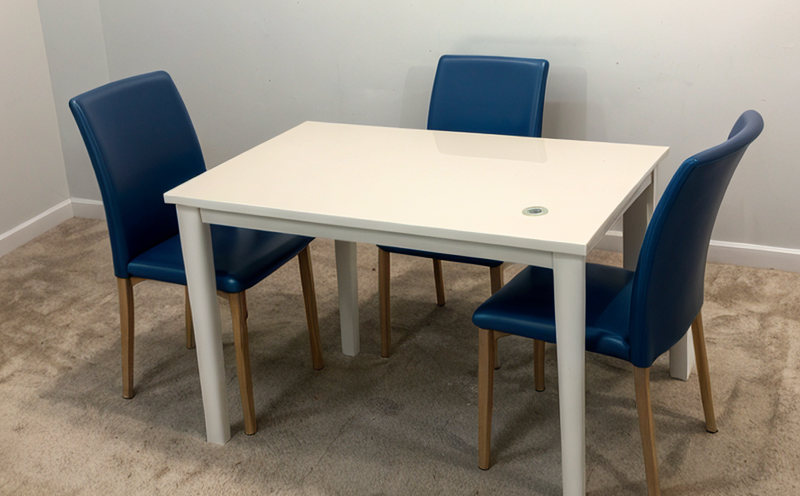EN 12721 Resistance to Wet Heat Testing of Furniture Plastics
The EN 12721 test evaluates the resistance of furniture plastics to wet heat exposure, ensuring their durability and stability under real-world conditions. This test is crucial for manufacturers aiming to meet regulatory requirements and ensure product longevity. In this section, we explore why this test matters in the context of furniture plastics, its significance for quality managers and compliance officers.
The EN 12721 standard specifies a procedure for assessing the resistance of plastic materials used in furniture components to wet heat exposure. The test simulates the conditions that furniture plastics may encounter during use, such as prolonged exposure to moisture and high temperatures. This is particularly important given the environmental stresses that furniture pieces can endure over their lifetime.
Materials like polypropylene (PP), polyethylene (PE), polystyrene (PS), and acrylonitrile butadiene styrene (ABS) are common in furniture design due to their durability, flexibility, and aesthetic appeal. However, these materials must perform reliably under various environmental conditions without degrading or losing their structural integrity.
The EN 12721 test helps manufacturers verify that the plastics used meet the required standards for resistance to wet heat exposure. This is essential for ensuring compliance with international regulations and gaining consumer trust in product quality. By adhering to this standard, manufacturers can ensure that their products remain robust and functional under typical usage conditions.
The test procedure involves placing a specimen of the plastic material into a controlled environment where it is subjected to both moisture and heat over an extended period. The specimen is then inspected for any signs of deterioration or failure. Compliance with this standard ensures that furniture plastics can withstand harsh environmental conditions, thereby enhancing product longevity and reliability.
For quality managers and compliance officers, the EN 12721 test provides a critical tool in ensuring that products meet stringent safety and performance standards. By conducting this test, they can verify that their materials are suitable for use in furniture components, thus avoiding costly recalls and maintaining consumer confidence.
Why It Matters
The resistance to wet heat testing is a vital step in the quality assurance process for furniture plastics. This test ensures that the plastic materials used in furniture are capable of withstanding environmental stressors, thus enhancing product longevity and reliability.
- Enhanced Durability: By simulating real-world conditions, this test helps ensure that furniture plastics remain robust over time.
- Increased Consumer Trust: Compliance with standards like EN 12721 builds confidence in the quality of the products, leading to higher customer satisfaction and loyalty.
- Avoidance of Regulatory Issues: Meeting regulatory requirements helps avoid potential legal issues and ensures that products are safe for use.
- Cost Savings: By identifying material flaws early in the development process, this test can save manufacturers from costly product recalls and replacements.
In conclusion, the EN 12721 resistance to wet heat testing is a critical component of furniture plastics quality assurance. It ensures that materials are reliable and durable under real-world conditions, thereby enhancing product performance and customer trust.
Scope and Methodology
The EN 12721 test evaluates the resistance of plastic materials used in furniture components to wet heat exposure. This includes polypropylene (PP), polyethylene (PE), polystyrene (PS), and acrylonitrile butadiene styrene (ABS) among others.
The test procedure involves placing a specimen into a controlled environment where it is exposed to both moisture and heat over an extended period. The specimen is then inspected for any signs of deterioration or failure. Compliance with this standard ensures that furniture plastics can withstand harsh environmental conditions, thereby enhancing product longevity and reliability.
Before the test begins, specimens are prepared according to specified dimensions and tolerances. Specimens are typically cut from larger sheets of plastic material using a precise cutting machine. The cutting process must be accurate to ensure consistent testing results.
The specimens are then placed into a moisture chamber where they are exposed to controlled levels of humidity for a specified period. After this, the specimens are transferred to a heat chamber where they are subjected to elevated temperatures for an additional duration. The combination of these conditions simulates real-world exposure scenarios that furniture plastics may encounter during use.
Once the test is complete, the specimens are inspected for any signs of deterioration or failure. This can include changes in color, texture, or structural integrity. Compliance with this standard ensures that furniture plastics remain robust and functional under typical usage conditions.
International Acceptance and Recognition
- The EN 12721 test is widely recognized as a key indicator of product reliability in the global market. Compliance with this standard ensures that furniture plastics are suitable for use in various environments.
- This test is accepted by numerous countries, including Europe, North America, and Asia. Its international recognition means that products meeting these standards can be sold globally without additional certification requirements in many regions.
- The standard is closely aligned with ISO 17654-2, which provides additional guidance on the use of plastics in furniture applications. Together, these standards ensure a high level of product quality and reliability.
- EN 12721 is also recognized by major industry organizations such as the International Organization for Standardization (ISO) and the European Committee for Standardization (CEN). This recognition further enhances its credibility and acceptance worldwide.
The widespread acceptance of EN 12721 underscores its importance in ensuring product quality and reliability. Manufacturers who comply with this standard can confidently sell their products globally, knowing that they meet stringent international standards.





